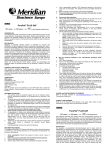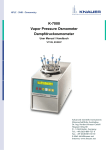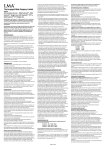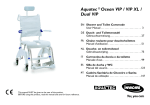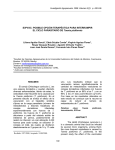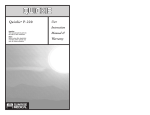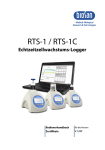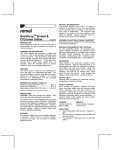Download ParaPak® PLUS ParaPak® PLUS - Meridian Bioscience Home
Transcript
b. c. d. 3. ENGLISH ® ParaPak PLUS 10% BUFFERED NEUTRAL FORMALIN 950405 ( 50) 950420 ( 200) In vitro diagnostic medical device INTENDED USE The integrated Para-Pak PLUS System provides a standardized procedure for the routine collection, transportation, preservation, filtration and examination of stool specimens for intestinal parasites. Kit systems are designed for easy use and afford an excellent means of minimizing the adverse effects of delay in specimen transportation. EXPLANATION Diagnosis of intestinal parasitic disease is confirmed by recovery and identification of helminth eggs and larvae, or protozoan trophozoites and cysts in the clinical parasitology laboratory. Timely collection and transportation of "fresh" specimens to the laboratory cannot always be insured. Workload conditions and priorities in clinical laboratories frequently do not allow immediate examination of "fresh" specimens. Procedures like incubation, refrigeration or freezing of stool samples will not guarantee the recovery of all diagnostic stages of all parasites. Proper use of the Para-Pak PLUS System assures the parasitologist that diagnostic stages of intestinal parasites will be preserved if present in the fecal material. CHEMICAL AND PHYSICAL PRINCIPLES Ten-percent formalin preserved specimens may be examined directly and concentrated for recovery of eggs, larvae and protozoan cysts. COMPONENTS 10% Formalin: Formalin 1.3 ml Distilled water 11.7 ml Phosphate Buffers 1.4 g/L Each kit consist of one vial containing 13 ml of 10% formalin preservative and a spatula for sample collection. Simple directions for patients and nursing personnel are also provided. MATERIALS NEEDED BUT NOT SUPPLIED Ethyl acetate (suggested) or dimethyl ether Physiological saline Cotton tipped applicator sticks Mricroscope slides and coverslip Centrifuge Microscope Transfer pipets SPECIMEN COLLECTION 1. The patients should be cautioned against the use of antiacids, barium, bismuth, antidiarrheal medication, or oily laxatives prior to collection of the specimen. 2. To assure recovery of parasitic elements which are passed intermittently and in fluctuating numbers, three specimens spaced few days apart must be examined. In the case of hospitalized patients it is suggested that all fecal passages be collected for a designated lenght of time to avoid prolonging the hospital stay. 3. The specimen is ideally passed into a bedpan but must not be contaminated with urine. Alternatively, a large plastic bag or wrapping film may be placed in the toilet opening and the specimen passed into the bag. Shake well the container for few seconds before opening. 4. An appropriate (i.e. bloody, slimy, watery) area of stool should be selected and sampled. Use the spatula to fill the sample collector attached to the vial cap. One scoopful is added to each container. This will results in approximately 1 ml (or 1 gram) of sample. Do not add more than the collector cavity can hold. Liquid specimens sholuld be collected using a small spoon. 5. Tighten the cap and shake firmly to insure that the specimen is adequately mixed. When mixing is completed the specimen should appear homogenous. 6. Label appropriately and send the vials to the laboratory. SPECIMEN PROCESSING The integrated Para-Pak PLUS System lends itself to a wide variety of procedures in common use. The following discussion is not exhaustive and alternatives can be found in the literature. 1. Gross examination: Record the presence of blood, worms, mucus or proglottids. 2. Direct microscopic examination from the 10% formalin preserved specimen: a. Place a clean glass slide on a sheet of newsprint. Add one drop of saline (iodine may be substituted if desired) to the slide. Add a representative sample of formalin preserved specimen to the drop of saline and mix thoroughly. The newsprint must be just legible through the slide. Place a coverslip on the suspension and examine immediately. Concentration procedure sedimentation): (formalin-ether or ethyl acetate a. Mix the 10% Formalin fixed specimen thoroughly. Remove the cap from the tip and place the spout into a centrifuge tube. Gently squeeze the vial. b. Add 1 drop of detergent. c. Add 3 ml of ethyl acetate, then stopper and shake the tube vigorously for few seconds. Carefully remove the stopper. d. Centrifuge at 500 x g for 10-15 minutes. e. Four layers will be apparent: Top layer: ethyl acetate or ether Second layer: plug of debris Third layer: formalin Bottom layer: sediment. f. After ringing the plug of debris from the sides of the tube with an applicator stick, carefully decant the top three layers. While keeping the tube inverted, a cotton swab may be used to remove debris sticking to the sides of the tube. This is particularly important for obtaining suitable results with ethyl acetate and avoids solvent bubbles in the wet mount. g. Add a few drops of physiological saline or 10% formalin to resuspend the remaining sediment. If the resulting slides are too dense (newsprint should be legible through them) more saline or formalin may be added. h. Iodine and saline mounts are suggested for microscopic examination. NOTE: If the pellet in step 7 contains a large amount of debris, wash step may be performed. Refloat the sediment in 7 ml water, shake and centrifuge at 2000 rpm. Pour off supernatant and continue with steps 7 and 8. PRECAUTIONS 1. Avoid contact of fixative solution with the skin and eyes. Should contact occur, flush with running water. If irritation should develop, see a physician. 2. Fixative solutions are poisonous. If ingested, dilute by drinking milk or water. Then call local poison center or physician immediately. 3. Due to the infectious nature of unpreserved stools, care and handwashing must be employed when the specimen is collected and manipulated. HAZARD and PRECAUTIONARY STATEMENTS Refer to the SDS, available at www.meridianbioscience.eu for Hazard and Precautionary Statements. STABILITY AND STORAGE Shelf life of the Para-Pak PLUS System is two years when stored at room temperature. Excessive heat and cold should be avoided. DEUTSCH ® ParaPak PLUS 10% BUFFERED NEUTRAL FORMALIN 950405 ( 50) 950420 ( 200) In Vitro Diagnosticum Das integrierte Para-Pak Plus System bietet ein standardisiertes Verfahren für Stuhluntersuchungen auf Darmparasiten. In einem speziellen Behälter wird das Probenmaterial gesammelt, transportiert, fixiert und auch gefiltert. Der Para-Pak Plus Kit vereinfacht für Patient und Labor die Handhabung der Stuhlprobe und erzeugt durch die Fixierung ein einwandfreies Untersuchungsmaterial, das genau wie eine frische Probe eine eindeutige Beurteilung zuläßt. ERLÄUTERUNGEN Die Diagnose von parasitischen Darmerkrankungen wird im Labor durch die Identifikation von Helminthen-Eiern und Larven oder Protozoen Trophozoiten und Cysten bestätigt. Nicht immer kann ein sofortiger Transport von "frischem" Stuhl ermöglicht werden oder auch die Bedingungen im Labor machen eine schnelle Untersuchung von "frischem" Stuhl unmöglich. Das Inkubieren, Kühlhalten und Einfrieren der Probe garantiert nicht, daß sich alle diagnostisch relevanten Stadien von allen Parasiten wiederfinden lassen(5,6,9,10,14,15). Die richtige Anwendung von Para-Pak Plus sichert dem Parasitologen diagnostisch relevante Formen von Darmparasiten, sofern sie in der Probe vorhanden sind. TESTPRINZIP Mit 10 % Formalin-fixierte Proben können direkt untersucht oder konzentriert werden, um Eier, Larven und Protozoen Cysten zu untersuchen. KIT-ZUSAMMENSETZUNG: 10% Formalin: Formalin 1,3 ml Aqua dest. 11,7 ml Phosphat puffer 1,4 g/l Jeder Kit besteht aus einem Behälter mit 13 ml 10 % Formalin Fixiermittel und einem Spatel für die Probenentnahme. Leicht verständliche Gebrauchsanweisungen für Patient und Laborpersonal sind ebenfalls vorhanden. 2. 3. ZUSÄTZLICH BENÖTIGTES MATERIAL Ethyläther (empfohlen) oder Dimethyläther Physiologische Kochsalzlösung Baumwolltupfer Objektträger und Deckgläschen Zentrifuge Mikroskop Pasteurpipetten UNTERSUCHUNGSMATERIAL 1. Die Patienten sollten darauf hingewiesen werden vor der Stuhlentnahme folgende Medikamente nicht einzunehmen: Antacida, Medikamente mit Barium oder Wismuth, Medikamente gegen Diarrhö oder ölhaltige Abführmittel. 2. Da die Parasiten in unterschiedlicher Menge ausgeschieden werden, müssen zur Erzielung sicherer Untersuchungsergebnisse drei Stuhlproben von verschiedenen auseinanderliegenden Tagen untersucht werden. Bei Krankenhauspatienten wird eine Probenentnahme von allen Stühlen über einen bestimmten Zeitraum empfohlen, um einen weiteren Krankenhausaufenthalt zu vermeiden (5,10). 3. Für die Stuhlentnahme ist eine Bettpfanne am geeignetsten. Der Stuhl darf jedoch nicht mit Urin in Berührung kommen. Man kann alternativ auch eine Plastiktüte oder eine Kunststoff-folie in die Toilettenöffnung legen, um den Stuhl darin aufzufangen. 4. Der Behälter wird einige Sekunden vor dem Öffnen geschüttelt. 5. Es sollte eine geeignete Stelle ( blutig, schleimig, wässrig) im Stuhl ausgewählt werden. Mit dem Spatel wird der Kollektor am Behälterdeckel gefüllt. Behälter werden so gefüllt, daß sich ca. 1 Gramm (1 ml) Stuhlprobe darin befinden. Es sollte nicht mehr Stuhl eingefüllt werden, als eine Vertiefung am Kollektor fassen kann. Flüssiges Untersuchungsmaterial mit einem kleinen Löffel einfüllen. 6. Behälter schließen und kräftig schütteln, so daß die Probe homogen verteilt wird. 7. Nun Behälter beschriften und ins Labor senden. PROBENAUFBEREITUNG Das integrierte Para-Pak Plus System ermöglicht die Anwendung verschiedener Methoden zur Parasitenidentifizierung. Im folgenden wird eine Möglichkeit aufgezeigt, weitere finden sich in der Literatur. 1. Grober Überblick: Erkennung von Blut, Würmern, Mukus oder Proglottiden. 2. Direkte mikroskopische Untersuchung von Untersuchungsmaterial, das mit 10 % Formalin fixiert wurde. a. Es wird ein sauberer Objektträger auf ein Stück Zeitungs-papier gelegt. b. Darauf wird ein Tropfen Kochsalzlösung oder Jodlösung gegeben. c. Nun wird das mit 10 % Formalin fixierte Probenmaterial auf den Objektträger gebracht und vermischt. Es sollte soviel Material gewählt werden, daß die Buchstaben der Zeitung gerade noch lesbar sind. d. Ein Deckglas auf die Suspension legen und sofort untersuchen. 3. a. (Formalin-Äther oder Ethylacetat Sedimentation) (7, 18) Die mit 10 % Formalin fixierte Probe sorgfältig mischen. Die Kappe entfernen und den Behälter umgedreht mit leichtem Druck in ein Standardzentrifugenröhrchen pressen. b. 1 Tropfen Detergens (z.B. Tween) zufügen. c. 3 ml Ethylacetat zugeben, verschließen und das Röhrchen einige Sekunden kräftig schütteln. Danach den Stöpsel vorsichtig abnehmen. d. 10-15 Minuten bei 500 x g zentrifugieren. e. Es entstehen 4 Schichten: Oberste Schicht: Ethylacetat oder Äther Zweite Schicht: Debris Dritte Schicht: Formalin Unterste Schicht: Sediment f. Die Schicht aus Debris muß vorsichtig mit einem Stäbchen von der Wand des Zentrifugenröhrchens gelöst werden. Danach können die oberen drei Schichten verworfen werden. Während das Röhrchen nach unten gehalten wird kann man mit einem Baumwolltupfer Debris von der Wand entfernen. Dies ist besonders wichtig um Lösungsmitteltropfen im Präparat zu zu vermeiden und gute Ergebnisse bei der Verwendung von Ethylacetat zu erzielen. g. Das Sediment wird in einigen Tropfen physiologischer Kochsalz-lösung oder 10 % Formalin aufgenommen. Die Verdünnung sollte so eingestellt werden, daß Zeitungspapier unter der Auftragstelle lesbar ist. Sollte dies nicht der Fall sein kann physiologische Kochsalzlösung oder Formalin zugegeben werden. h. Untersuchungsmaterial, das mit Kochsalz- oder Jodlösung aufgenommen wurde, eignet sich am besten für eine mikroskopische Beurteilung. Achtung: Falls das Sediment ( Punkt 7 ) zu viel Debris enthält, kann ein weiterer Waschschritt durchgeführt werden. Dazu wird das Sediment in 7 ml Wasser aufgenommen, geschüttelt und bei 2000 rpm abzentrifugiert. Man verwirft den Überstand und fährt bei Punkt 7 fort. GESUNDHEITS- UND SICHERHEITSANWEISUNGEN 1. Haut- und Schleimhautkontakt mit der Fixierlösung sind zu vermeiden. Sollte es jedoch zu einem Kontakt kommen, dann die betroffene Stelle gründlich unter fließendem Wasser abwaschen. Bei Hautveränderungen muß ein Arzt aufgesucht werden. Die Fixierlösung ist giftig. Falls die Lösung aufgenommen wurde, sofort Wasser nachtrinken und einen Arzt konsultieren. Der unfixierte Stuhl ist infektiös, deshalb sollten bei der Probenentnahme Handschuhe getragen werden und die Hände danach gründlich gereinigt werden. GEFÄHRDUNGEN UND SICHERHEITSHINWEISE Für weitere Informationen zu den Gefahren- und Sicherheitshinweisen, beziehen Sie sich aur die SDS, die unter folgendem Link verfügbar sind www.meridianbioscience.eu. REAGENZIENHALTBARKEIT UND LAGERUNG Para-Pak Plus kann 2 Jahre bei Raumtemperatur gelagert werden. Es sollte extreme Hitze oder Kälte vermieden werden. ITALIANO ® ParaPak PLUS 10% BUFFERED NEUTRAL FORMALIN 950405 ( 50) 950420 ( 200) per uso diagnostico in vitro FINALITÀ D'USO Para-Pak PLUS è un sistema standardizzato per la raccolta, il trasporto, la fissazione, la filtrazione e l'esame dei campioni fecali per la ricerca di parassiti intestinali. Il prodotto può essere facilmente utilizzato da tutto il personale di laboratorio e risolve i problemi legati ad una non immediata consegna del campione. SPIEGAZIONE La diagnosi delle malattie parassitarie intestinali viene confermata mediante l'osservazione microscopica delle uova e delle larve di Elminti e dei trofozoiti o delle cisti di Protozoi, eventualmente presenti. Non sempre è però possibile assicurare il trasporto di un campione "fresco" di feci al laboratorio, entro i 30 minuti dall'emissione come raccomandato dalle procedure. Inoltre, altre priorità del laboratorio spesso non consentono l'immediato esame dei campioni freschi di feci. Le tecniche di incubazione, refrigerazione o congelamento, in questi casi non garantiscono la conservazione di tutte le forme diagnostiche di ogni parassita. Pertanto viene raccomandato l'utilizzo di un sistema di fissazione del materiale fecale, immediatamente dopo l'emissione (5,6,9,10,14,15). Il sistema Para-Pak PLUS garantisce al laboratorista la conservazione ottimale delle forme diagnostiche dei parassiti intestinali eventualmente presenti nel materiale fecale. I campioni fissati in formalina al 10% possono essere esaminati direttamente al microscopio. oppure concentrati per evidenziare uova e larve di Elminti e cisti di Protozoi. COMPOSIZIONE Formalina al 10%: Formalina 1.3 ml Acqua distillata 11.7 ml Tampone fosfato 1.4 g/l Il prodotto è costituito da un contenitore con 13 ml di formalina al 10% e da una spatola di legno per la raccolta del campione. Il sistema viene fornito con un foglietto di istruzioni per il corretto prelevamento delle feci da parte del personale infermieristico o da parte del paziente stesso. MATERIALI NECESSARI MA NON FORNITI Etile acetato (consigliato), oppure etere Soluzione fisiologica Tamponi non sterili Vetrini portaoggetto e coprioggetto Centrifuga Microscopio Pipette Pasteur RACCOLTA DEL CAMPIONE 1. Il paziente deve essere avvisato di non assumere antiacidi, bario, bismuto, farmaci antidiarroici o lassativi oleosi prima della raccolta del campione. 2. Per assicurare l'evidenziazione degli elementi parassitari, che vengono emessi in modo discontinuo ed in quantità variabile, si consiglia di esaminare tre campioni di feci emessi ad alcuni giorni di distanza l'uno dall'altro. (5,10). 3. Il campione teoricamente dovrebbe essere raccolto in una padella o in altro contenitore a bocca larga, ma non deve essere contaminato con le urine. In alternativa, si può inserire un foglio di pellicola di materiale plastico sotto il sedile del water, per consentire la raccolta del campione. Prima di prelevare il campione, agitare vigorosamente il contenitore. 4. Si raccomanda di raccogliere un campione significativo di feci (ad es., dalle aree che si presentano sanguinolente, mucoidi o acquose) utilizzando la spatola di legno fornita, e di riempire una sola volta il dispositivo per il prelevamento standardizzato del campione, che si trova attaccato al coperchio del contenitore: in questo modo verrà prelevato circa 1 ml (o 1 gr) di feci. Non aggiungere materiale in eccesso a quanto la cavità del dispositivo di prelievo può contenerne. Le feci liquide possono essere raccolte con un cucchiaino. 5. 6. Richiudere bene il contenitore ed agitarlo vigorosamente, per ottenere una adeguata miscelazione del campione. Alla fine dell'operazione il campione dovrebbe avere un aspetto omogeneo, cioè non dovrebbero essere presenti grumi di materiale fecale. Scrivere il nome del paziente sull'etichetta ed inviare il contenitore al laboratorio. TRATTAMENTO DEL CAMPIONE Il Sistema Para-Pak PLUS consente l'utilizzo di gran parte delle tecniche in uso comunemente. Le istruzioni che seguono non sono assolute e chiunque può trovare delle alternative nella bibliografia. 1. 2. 3. Esame macroscopico diretto. Registrare l'eventuale presenza di sangue, vermi, muco or proglottidi prima di introdurre il campione nel contenitore contenente il fissativo. Esame microscopico diretto dei campioni fissati in formalina al 10% a. Porre su un vetrino pulito una goccia di soluzione fisiologica (o di Lugol, a scelta). b. Aggiungere una porzione rappresentativa del campione fissato in formalina alla goccia di soluzione fisiologica e mescolare bene il tutto. La corretta densità del preparato sarà quella che consente la lettura dei caratteri di stampa attraverso il preparato. c. Coprire il tutto con un vetrino coprioggetto ed esaminare immediatamente. Tecnica di concentrazione con formalina-etere (o etile acetato) (7,18) a. Agitare bene il campione. Togliere il tappino colorato e capovolgere il tutto sopra una provetta da centrifuga. Premere delicatamente il contenitore di plastica per facilitare la filtrazione. b. Aggiungere 1 goccia di surfattante (Triton X o equivalente). c. Aggiungere 3 ml di etile acetato o etere, tappare ed agitare vigorosamente per alcuni secondi, capovolgendo la provetta. Sollevare il tappo con precauzione, per eliminare una eventuale sovrapressione. d. Centrifugare a 500 x g per 10-15 minuti. e. Saranno a questo punto visibili 4 strati: - Primo strato in alto: etile acetato o etere - Secondo strato: tappo di detriti - Terzo strato: formalina - Ultimo strato: sedimento. f. Dopo aver rimosso il tappo di detriti dalle pareti della provetta con un bastoncino, con attenzione eliminare i primi tre strati. Tenendo la provetta capovolta, pulire le pareti interne con un tampone asciutto. Questa operazione è particolarmente importante al fine di ottenere buoni risultati con l'etile acetato ed evitare la presenza di bolle di solvente nei preparati microscopici a fresco. g. Aggiungere poche gocce di soluzione fisiologica o di formalina al 10% per risospendere il rimanente sedimento. Se i vetrini preparati con esso dovessero risultare troppo densi (i caratteri di stampa dovrebbero essere appena leggibile attraverso il preparato), si può aggiungere ancora soluzione fisiologica o formalina. h. Per l'esame microscopico si consiglia di usare Lugol (che può essere anche aggiunto direttamente nella provetta) oppure soluzione fisiologica. PRECAUZIONI 1. Evitare il contatto del fissativo con la pelle e gli occhi. Se ciò si verifica, lavare con acqua corrente. Contattare un medico se si sviluppa irritazione. 2. Le soluzioni di fissativo sono velenose. Se ingerite, si consiglia di bere latte o acqua e di ricorrere al più vicino Pronto Soccorso. 3. A causa della natura infettiva delle feci, bisogna prestare attenzione quando si preleva e si maneggia il campione e si raccomanda di lavarsi bene le mani una volta effettuata questa operazione o di utilizzare guanti di protezione. 4. Anche i campioni fissati in formalina al 10% devono essere maneggiati come materiale potenzialmente infettivo. DICHIARAZIONI DI PERICOLO E PRUDENZA Fare riferimento alla Scheda di Sicurezza SDS, disponibile www.meridianbioscience.eu per i rischi e i consigli di prudenza sul sito STABILITÀ 2 anni dalla data di preparazione, se conservato a temperatura ambiente. FRANÇAIS ® ParaPak PLUS 10% BUFFERED NEUTRAL FORMALIN 950405 ( 50) 950420 ( 200) Pour diagnostic in vitro USAGE Le système Para-Pak PLUS fournit une procédure de routine standardisée de récolte, de transport, de conservation, de filtration et d’examen d’échantillons de selles pour la recherche de parasites intestinaux. Ce kit est conçu pour une utilisation facile et apporte un excellent moyen de minimiser les effets indésirables dûs aux délais des échantillons. EXPLICATIONS Le diagnostic de maladies parasitaires intestinales est confirmé au laboratoire de parasitologie clinique par l’isolement et l’identification des oeufs et des larves d’helminthes ou des trophozoïtes et des cystes de protozoaires. La récolte et le transport d’ échantillons “frais” vers le laboratoire ne peuvent pas toujours se faire dans les temps requis. Les conditions de travail et les urgences au laboratoire ne permettent pas toujours un examen direct des échantillons “frais”. Les procédures comme l’incubation, la réfrigération ou la congélation des échantillons de selles ne permettent pas de garantir l’isolement de tous les stades diagnostiques de tous les parasites (5,6,9,10,14,15). Une utilisation convenable du système Para-Pak PLUS garantit au parasitologiste que les stades diagnostiques des parasites intestinaux éventuellement présents seront préservés. PRINCIPES PHYSICO-CHIMIQUES Les échantillons conservés dans du formol à 10% peuvent être examinés directement et concentrés pour isoler les oeufs, les larves ou les cystes de protozoaires. COMPOSANTS Formol à 10% Formol 1,3 ml Eau distillée 11,7 ml Tampons phosphate 1,4 g/l Chaque kit est constitué d’un flacon contenant 13 ml de formol à 10% comme conservateur et d’une spatule pour la récolte des échantillons. Un mode d’emploi simple est également fourni pour les malades et le personnel soignant. MATERIEL NECESSAIRE MAIS NON FOURNI Acetate d’éthyle (conseillé) ou diméthyl ether Sérum physiologique Batonnets d’application à extrémité coton Lames de microscope et lamelles Centrifugeuse Microscope Pipettes de transfert RECOLTE DE L’ECHANTILLON 1. Le patient devra être prévenu de ne pas prendre d’anti-acides, de baryura, de bismuth, de traitements antidiarrhéiques ou de laxatifs huileux avant la récolte de l’échantillon. 2. Pour assurer l’isolement des éléments parasitaires qui sont émis de manière intermittente et en quantité variable, trois échantillons espacés de quelques jours seront examinés. Dans le cas de patients hospitalisés il est préférable de récolter tous les passages fécaux sur une durée définie afin d’éviter un séjour prolongé à l’hopital (5,10). 3. L’échantillon sera récolté de préférence dans un bassin de lit mais ne devra pas être contaminé par l’urine. Il est également possible d’installer un grand sac plastique ou un film d’emballage sur le siège des toilettes et d’y mettre l’échantillon. Bien agiter le récipient pendant quelques secondes avant de l’ouvrir. 4. Une zone appropriée des selles (par ex. liquide, visqueuse, sanguinolente) sera choisie pour prélever l’échantillon. A l’aide de la spatule, remplir le collecteur d’échantillon attaché au bouchon du flacon. Ajouter une dose de spatule dans chaque récipient. Cela correspondra environ à 1 ml (ou 1 g) d’échantillon. Ne pas mettre plus que ce que la cavité du collecteur peut contenir. Les échantillons liquides devront être collectés à l’aide d’une petite cuillère. 5. Fermer le bouchon et agiter vigoureusement pour mélanger correctement l’échantillon. Quand le mélange est effectué, l’échantillon doit présenter un aspect homogène. 6. Etiqueter de manière appropriée et envoyer les flacons au laboratoire. TRAITEMENT DES ECHANTILLONS Le système Para-Pak PLUS se prête à une grande variété de procédures en usage courant. La liste suivante n’est pas exhaustive et d’autres possibilités peuvent être trouvées dans la littérature. 1. Examen macroscopique : noter la présence de sang, de vers, de mucus ou de proglottides. 2. Examen microscopique direct de l’échantillon conservé dans du formol à 10% : a. Placer une lame de verre propre sur une feuille de papier journal. b. Déposer une goutte de sérum physiologique (on peut le remplacer par de l’iode si on le souhaite) sur la lame. c. Ajouter un échantillon représentatif de l’échantillon formolé à la goutte de sérum physiologique et mélanger soigneusement. La papier journal doit être juste lisible à travers la lame. d. Recouvrir la suspension avec une lamelle et observer immédiatement. 3. Procédure de concentration (sédimentation formol-ether ou formolacétate d’éthyle) (7,18): a. Mélanger soigneusement l’échantillon fixé au formol à 10%. Enlever le ouchon de l’extrémité et verser le jet dans un tube à centrifugation. Presser légèrement le flacon. b. Ajouter une goutte de détergent. c. Ajouter 3 ml d’acétate d’éthyle, puis mettre le bouchon et agiter le tube vigoureusement pendant quelques secondes. Enlever le bouchon avec précaution. d. Centrifuger à 500 x g pendant 10-15 minutes. e. On distingue 4 couches: Couche supérieure: acétate d’éthyle ou éther Deuxième couche: bouchon de débris Troisième couche: formol Couche inférieure: sédiment f. Après avoir décollé le bouchon de débris des parois du tube avec un batonnet d’application, décanter les trois couches supérieures. Une tige cotonnée peut être utilisée pour enlever les débris collant aux parois du tube, en gardant le tube retourné. Ceci est particulièrement important pour obtenir des résultats fiables avec l’acétate d’éthyle et permet d’éviter les bulles de solvant dans le montage humide sur lame. g. Ajouter quelques gouttes de sérum physiologique ou de formol à 10% pour remettre le sédiment en suspension. Si les lames obtenues sont trop opaques (on doit pouvoir lire le papier journal à travers), il est possible de rajouter un peu de sérum physiologique ou de formol. h. Des montages dans de l’iode et dans du sérum physiologique sont conseillés pour l’observation microscopique. REMARQUE: Si le pellet de l’étape 7 contient un grand nombre de débris, il est possible d’effectuer une étape de lavage. Remettre le sédiment dans 7 ml d’eau, agiter et centrifuger à 2000 rpm. Jeter le surnageant et passer aux étapes 7 et 8. PRECAUTIONS D’EMPLOI 1. Eviter tout contact de la solution de fixateur avec la peau et les yeux. En cas de contact, rincer sous l’eau courante. S’il se développe une inflammation, consulter votre médecin. 2. Les solutions de fixateur sont toxiques. En cas d’ingestion, diluer en buvant de l’eau ou du lait. Puis appeler immédiatement votre centre antipoisons le plus proche ou votre médecin. 3. Compte tenu de la nature infectieuse des selles non traitées, il faut se laver les mains et prendre des précautions lors de la récolte et de la manipulation des échantillons. DANGER ET MISES EN GARDE Pour les dangers et les précautions à prendre, se référer à la fiche de sécurité, disponible sur le site web de Meridian Bioscience www.meridianbioscience.eu. STABILITE ET STOCKAGE La durée de stockage du système Para-Pak PLUS est de deux ans à température ambiante. Eviter la chaleur ou le froid excessif. ESPAÑOL ® ParaPak PLUS 10% BUFFERED NEUTRAL FORMALIN 950405 ( 50) 950420 ( 200) Para uso diagnóstico in vitro UTILIZACIÓN El Sistema integrado Para-Pak PLUS proporciona un procedimiento estandarizado para la toma, transporte, conservación, filtración y examen de parásitos intestinales a partir de muestras de heces. Los sistemas están diseñados para una fácil utilización y proporcionan un medio excelente para minimizar los efectos adversos del retraso en el transporte de la muestra. EXPLICACIÓN El diagnóstico de una enfermedad parasitaria intestinal se confirma a través de la recuperación e identificación de huevos y larvas de helmintos o trofozoitos y quistes de protozoos en el laboratorio de parasitología clínica. La toma y transporte a tiempo al laboratorio de muestras “frescas” no puede asegurarse siempre. Las prioridades y condiciones de trabajo en los laboratorios clínicos, frecuentemente no permiten un examen inmediato de las muestras “frescas”. Los procedimientos como la incubación, refrigeración o congelación de las muestras de heces no van a garantizar la recuperación de todas las fases diagnósticas de todos los parásitos. El uso adecuado del Sistema Para-Pak PLUS asegura al parasitólogo que las fases diagnósticas de los parásitos intestinales serán conservadas si están presentes en la materia fecal. PRINCIPIOS QUÍMICOS Y FÍSICOS Las muestras conservadas con formalina al diez por ciento pueden ser examinadas directamente y concentradas para la recuperación de huevos, larvas y quistes de protozoos. COMPONENTES Formalina 10%: Formalina 1.3 ml Agua destilada 11.7 ml Tampones Fosfato 1.4 g/L Cada kit consiste en un vial que contiene 13 ml de formalina 10% como conservante y una espátula para toma de muestra. También se proporcionan instrucciones simples para los pacientes y el personal sanitario. MATERIALES NECESARIOS PERO NO SUMINISTRADOS Acetato de etilo (aconsejado) o éter dimetílico Salina fisiológica Hisopos con punta de algodón Portaobjetos y cubreobjetos Centrífuga Microscopio Pipetas de transferencia TOMA DE MUESTRA 1. Los pacientes deben ser prevenidos contra el uso de antiácidos, bario, bismuto, medicación antidiarreica o laxantes lubrificantes antes de la toma de muestra. 2. 3. 4. 5. 6. Para asegurar la recuperación de elementos parasitarios, los cuales se presentan intermitentemente y en número fluctuante, se deben examinar tres muestras espaciadas unos pocos días entre ellas. En el caso de pacientes hospitalizados se aconseja que todas las muestras fecales sean recogidas en un período de tiempo designado para así evitar estancias prolongadas en el hospital. La muestra se recoge de modo ideal con una cuña pero no debe estar contaminada con orina. De manera alternativa, se puede colocar en el inodoro abierto una bolsa de plástico grande o un plástico envolvente y depositar así la muestra en la bolsa. Agitar bien el contenedor durante unos segundos antes de abrirlo. Se debería seleccionar y tomar la muestra de un área apropiada de las heces (p.e. sanguinolenta, viscosa). Utilice la espátula para llenar el recolector de muestra incorporado en el tapón del vial. Se añade una cucharada llena a cada contenedor. Eso significará aproximadamente 1 ml (o 1 gramo) de muestra. No añada más muestra de la que quepa en la cavidad del recolector. Las muestras líquidas deberían ser recogidas utilizando una cuchara pequeña. Apriete bien el tapón y agite el vial firmemente para asegurar que la muestra se mezcla adecuadamente. La muestra debería aparecer homogénea cuando la mezcla se ha completado. Etiquete los viales adecuadamente y mándelos al laboratorio. PROCESAMIENTO DE LA MUESTRA El Sistema integrado Para-Pak PLUS, se presta a una gran variedad de procedimientos de uso común. La siguiente proposición no es exhaustiva y se pueden encontrar alternativas en la literatura. 1. Examen Bruto: Registrar la presencia de sangre, lombrices, mucosidad o proglótidos. 2. Examen microscópico directo desde la muestra conservada en formalina 10%: a. Coloque un portaobjetos limpio sobre la hoja de un periódico. b. Añada una gota de salina (se puede emplear yodina si se desea) al porta. c. Añada una muestra representativa del especímen conservado en formalina a la gota de salina y mezcle cuidadosamente. El periódico debe ser legible a través del porta. d. Coloque un cubreobjetos sobre la suspensión y examínela de inmediato. 3. Proceso de concentración (sedimentación formalina-éter o acetato de etilo): a. b. c. d. e. f. g. h. Agite la muestra fijada con Formalina 10% cuidadosamente. Saque el tapón de la punta y coloque la punta dentro de un tubo de centrífuga. Exprima el vial suavemente. Añada 1 gota de detergente. Añada 3 ml de acetato de etilo, después tape y agite el tubo vigorosamente durante unos segundos. Saque el tapón cuidadosamente. Centrifugue a 500 x g durante 10-15 minutos. Aparecerán cuatro capas: Capa superior: acetato de etilo o éter Segunda capa: restos de materia fecal Tercera capa: formalina Capa inferior: sedimento. Después de quitar el resto de materia fecal de los laterales del tubo con una varilla aplicadora, decante cuidadosamente las tres capas superiores. Manteniendo el tubo invertido, saque el exceso de acetato de etilo y restos de materia fecal de los laterales del tubo con una varilla de algodón. Esto es particularmente importante para obtener resultados apropiados con acetato de etilo y evitar burbujas de disolvente en la preparación fresca. Añada unas pocas gotas de salina fisiológica (o formalina 10%) para resuspender el sedimento restante. Si los portas resultantes son demasiado densos (se debería poder leer un papel de periódico a través de ellos), se puede añadir mas salina o formalina 10%. Para examen microscópico se sugiere el montaje con yodina y salina. NOTA: Si el sedimento en el paso 7 contiene una gran cantidad de restos de material fecal, se debe realizar un paso de lavado. Resuspenda el sedimento en 7 ml de agua, agite y centrifugue a 2000 rpm. Decante el sobrenadante y continúe con los pasos 7 y 8. PRECAUCIONES 1. Evite el contacto de la solución fijadora con la piel y los ojos. Si se diera el contacto, lave la zona afectada abundantemente con agua corriente. Si se desarrolla irritación, vea a un médico. 2. Las soluciones fijadoras son venenosas. Si se diera ingestión, dilúyala bebiendo leche o agua. Después llame a un centro de toxicología o a un médico inmediatamente. 3. Debido a la naturaleza infecciosa de las heces no conservadas, se debe emplear cuidado y lavarse las manos cuando la muestra es recogida y manipulada. DECLARACIONES DE RIESGO Y PRECAUCIÓN Se debe referir a los SDS, disponsible en www.meridianbioscience.eu ESTABILIDAD Y ALMACENAMIENTO La caducidad del Sistema Para-Pak PLUS es de 2 años almacenado a temperatura ambiente. Se debe evitar excesivo calor y frío. BIBLIOGRAPHY/REFERENZEN/BIBLIOGRAFIA/REFERENCES BIBLIOGRAPHIQUES 1. Bartlett, M. et al. 1978. Comparative evaluation of a modified zinc sulfate flotation technique. J. Clin. Microbiol. 7: 524-8. 2. Brooke, M.M. and M. Goldman. 1944. Polyvinyl alcohol fixative as a preservative and adhesive for protozoa in dysenteric stools, and other liquid materials. J. Lab. Clin. Med. 34: 1554-60. 3. Brooke, M.M. and C. Norman. 1955. The effectiveness of the PVA fixative tecnique in revealing intestinal amoebae in diagnostic cultures. Am. J. Trop. Med. Hyg. 4: 479-82. 4. Brooke, M.M. 1960. PVA fixative technique in laboratory confirmation of amebiasis. Triangle 4: 326-35. 5. Brooke, M.M. 1974. "Intestinal and Urogenital Protozoa". In: Manual of Clinical Microbiology, American Society for Microbiology, Washington, D.C., 2nd Edition, pp. 582-601. 6. Burrows, R.B. 1965. Microscopic Diagnosis of the Parasites of Man, Yale University Press, New Haven, pp. 319-81. 7. Erdman, D. 1981. Clinical comparison of ethyl acetate and dimethyl ether in the formalin-ether sedimentation technique. J. Clin. Microbiol. 14: 483-5. 8. Faust, E.C. et al. 1938. A critical study of clinical laboratory techniques for the diagnosis of protozoan cysts and helminth eggs in feces. Am. J. Trop. Med. Hyg. 18: 169-83. 9. Garcia, L.S. and L. Ash. 1979. Diagnostic Parasitology. C.V. Mosby Co., St. Louis. pp. 9-24. 10. Haper, K. et al. 1957. Advantages of the PVA fixative two-bottle stool collection technique in the detection and identification of intestinal parasites. Publ. Health Lab. 15: 96-108. 11. Markell, E.K. and P.M. Quinn. 1977. Comparison of immediate and polyvinyl alcohol (PVA) fixation with delayed Schaudin's fixation for the demonstration of protozoa in stool specimens. Am. J. Trop. Med. Hyg. 26: 113942. 12. Melvin, D.M. and M.M. Brooke. 1975. Laboratory Procedure for the Diagnosis of Intestinal Parasites, U.S. Department of Health, Education and Welfare Publication [CDC]-75-82821, Atlanta, GA, pp. 23-85. 13. Ritchie, L.S. et al. 1952. A comparison of the zinc sulfate and the MGL (formalin-ether) technique. J. Parasit. 38: 16. 14. Scholten, T.H. and J. Yang. 1974. Evaluation of unpreserved and preserved stools for the detection and identification of intestinal parasites. Am. J. Clin. Path. 62: 563-7. 15. Swartzwalder, J.C., G.W. Hunter, W.W. Frye. 1966. Manual of Tropical Medicine, W.B. Saunders Co., Philadelphia. 16. Simitch, T. and Z. Petrovich. 1953. Longevitè de la forme vegetativè de dysenterioe dans divers milieaux. Arch. Inst. Pasteur d'Algerie 31: 375-80. 17. Wheatley, W.B. 1951. A rapid staining procedure for intestinal amoebae and flagellates. Am. J. Clin. Path. 2: 990-1. 18. Young, K.H. et al. 1979. Ethyl acetate as a substitute for dimethyl ether in the formalin-ether sedimentation technique. J. Clin. Microbiol. 10: 852 Manufactured by Meridian Bioscience Europe S.r.L Via dell’ Industria, 7 - 20020 Villa Cortese, Milano ITALY Tel: +39 0331 43 36 36 - Fax: +39 0331 43 36 16 Email: [email protected] WEB: www.meridianbioscience.eu Meridian Bioscience Europe s.a/n.v. 2 Avenue du Japon - 1420 Braine l’Alleud BELGIUM Tel: +32 (0) 67 89 59 59 - Fax: +32 (0) 67 89 59 58 Email: [email protected] Meridian Bioscience Europe s.a. 34 rue de Ponthieu - 75008 Paris FRANCE Tel: +33 (0)1 42 56 04 40 - Fax: +33 (0)9 70 06 62 10 Email: [email protected] Meridian Bioscience Europe b.v. Postbus 301 - 5460 AH Veghel NETHERLANDS Tel: +31 (0) 411 6211 66 - Fax: +31 (0) 411 6248 41 Email: [email protected] Key guide to symbols / Guide des symboles/Guida ai simboli/ Guia de simbolos/ Erlauterung der graphischen symbole Expiry date / Date de péremption/ Scadenza/ Fecha de caducidad/ Haltbarkeitsdatum Lot number /Numéro de lot / Numero di lotto/ Número de lote / Chargenbezeichnung For in vitro diagnostic use / Usage in vitro/ Per uso diagnostico in vitro Uso diagnóstico in vitro / In vitro Diagnosticum This product fulfills the requirements of Directive 98/79/EC on in vitro diagnostic medical devices / Ce produit répond aux exigences de la Directive 98/79 CE relative aux dispositifs médicaux de diagnostic in vitro/ Questo prodotto soddisfa i requisti della Direttiva 98/79/CE sui dispositivi medico-diagnostici in vitro/ Este producto cumple con las exigencias de la Directiva 98/79/CE sobre los productos sanitarios para diagnóstico in vitro/ Dieses Produkt entspricht den Anforderungen der Richtlinie über In Vitro Diagnostica 98/79/EG Catalogue number / Référence article/Codice dell’articolo/ Número de catálogo / Artikelnummer Please read pack insert / Lire attentivement le mode d’emploi / Leggere il foglietto informativo/ Leer instrucciones de uso / Bitte Packungsbeilage beachten Rev. 03/2015 Manufactured by / Fabriqué par/ Prodotto da / Fabricado por / Hergestellt von For technical assistance and ordering, contact Meridian Bioscience Europe or your Local Distributor (www.meridianbioscience.eu) Contains sufficient for <n> tests / Contenu suffisant pour "n"tests/ Contenuto sufficiente per “n” prove/ Contenido suficiente para <n> ensayos / Enthält ausreichend für <n> Tests Conservare a/ Store at / Conserver entre/ Conservar a/ Lagerung bei





